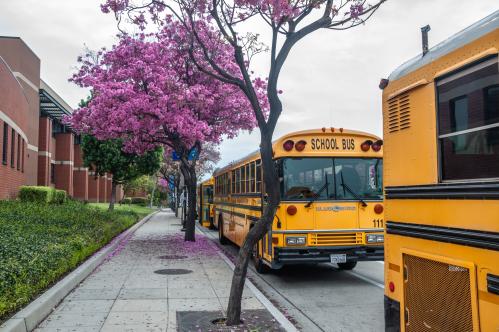Introduction
The American dream is built on the promise of upward social mobility. In the middle of the 20th century, rates of upward mobility improved across the socioeconomic spectrum. But over the course of the past 30 years, the vast majority of our population has seen mobility rates stagnate.1 For too many, the American dream has stalled.
Restoring higher levels of social mobility will be among the most important political, social, and economic challenges of our time. Already, we’ve witnessed how frustration over this stagnation can destabilize our national institutions and divide our society. The longer we wait to address the issue, the more tumultuous our politics will become.
Making greater and more effective investments in children and youth will be the best way to improve social mobility throughout the nation. Research has demonstrated the positive long-term effects of providing a specific set of coordinated interventions from “cradle to career.”2 Despite the conclusive evidence, our nation has been unable to provide those in need with access to the right kinds of services.
The time to act is now. The question is, who will lead the effort to expand these proven strategies? Over the past decade, it has become apparent that we cannot rely upon the federal government or the states. Washington and many state governments have been hijacked by partisanship, leading to paralysis on or hostility toward many of the policies and interventions necessary for improving outcomes for children and youth. The Trump administration’s May 2017 budget proposal called for nearly $10 billion in cuts to after-school funding, summer initiatives, teacher training, financial aid for lower-income students, and similar programs.3
The budgetary trend lines are also unmistakable. At the federal level, demographic realities are driving up spending on Social Security, Medicare, and Medicaid. This will place enormous pressure on Washington’s contributions to programs for children and youth, which are expected to decline over the next decade by 25 percent or more as a percentage of GDP.4 As Eugene Steuerle notes in his 2014 book Dead Men Ruling, only 2 percent of the projected $1.5 trillion increase in federal spending over the next decade will go to children.5 And while some state governments have demonstrated a steady commitment to improving outcomes for youth, many are providing less funding for children now than they were before the Great Recession.6
Fortunately, as higher levels of government have faltered, cities, counties, and metropolitan areas have stepped up. Local leaders have recognized that the issue of stagnant opportunity is far too urgent to wait for other levels of government to act. In communities across the country, leaders in local governments have joined forces with nonprofits, philanthropies, and businesses to increase the magnitude, quality, and coordination of cradle-to-career investments in the next generation.
These communities have realized that the existing composition of investments in young people, dominated by the safety net and the public education system, are not enough to meet the challenges of the 21st century. Technology and global competition have come to demand a higher degree of skills training than ever before, and many of the fastest growing demographic groups in our country face the steepest educational and developmental challenges. For local leaders, ensuring that children have access to meaningful opportunities is more than a social responsibility—it is an economic imperative for their communities.
Communities are therefore expanding programs that stretch well beyond the traditional set of public services provided to youth. They are investing in efforts like nurse visiting programs, early childhood education, supplemental academic and social curricula, after-school programs, and summer learning initiatives. They are tailoring interventions to align with their specific needs, coordinating across sectors and silos, and most importantly, drawing upon new sources of revenue to finance these efforts.
These locally driven approaches to investing in children and youth are a part of a larger national trend. Over the past decade or so, cities and metropolitan areas have risen to the forefront of national problem solving across a wide range of policy areas. Solutions to many of our toughest problems—mitigating the effects of climate change, financing major infrastructure projects, creating more innovative economies, to name a few—are now being crafted at the local level.7 In communities of all stripes, leaders in every sector have come together to solve local problems at a level of sophistication that would have been unthinkable a few decades ago. As this self-sufficient and intensely networked style of local leadership has spread, it has given rise to a national movement—a New American Localism.
This paper provides an overview of the challenges associated with improving outcomes for children and youth, the intergovernmental obstacles that communities face as they expand supplemental cradle-to-career services, and the strategies individual communities have drawn upon to deliver better results for the next generation.
-
Footnotes
- David Leonhardt, “The American Dream, Quantified at Last,” New York Times, December 8, 2016.
- Isabelle V. Sawhill and Quentin Karpilow, “How Much Could We Improve Children’s Life Chances by Intervening Early and Often?” Brookings Institution, March 2015.
- Stephenie Johnson et al., “The Trump-DeVos Budget Would Dismantle Public Education, Hurting Vulnerable Kids, Working Families, and Teachers,” Center for American Progress, March 17, 2017.
- Sara Edelstein et al., “Kids Share 2016: Federal Expenditures on Children Through 2015 and Future Projections,” Urban Institute, 2016.
- Eugene Steuerle, Dead Men Ruling: How to Restore Fiscal Freedom and Rescue Our Future (New York, NY: Century Foundation, 2014).
- Michael Leachman et al., “Most States Have Cut School Funding, and Some Continue Cutting,” Center on Budget and Policy Priorities,” January 25, 2016.
- Megan Greenwalt, “DC Water Authority Unveils WTE Project,” Waste 360, November 3, 2015; Meghan McCarty and Aaron Mendelson, “LA Says ‘Yes’ to Tax Increase for Transportation,” 89.3 KPCC, November 9, 2016; Bruce Katz and Julie Wagner, “What a City Needs to Foster Innovation,” Brookings Institution, January 16, 2014.










